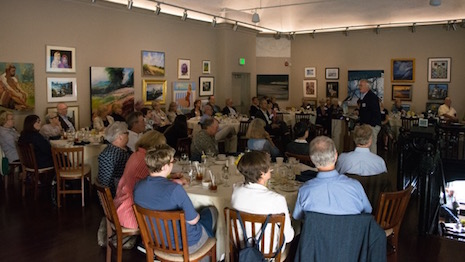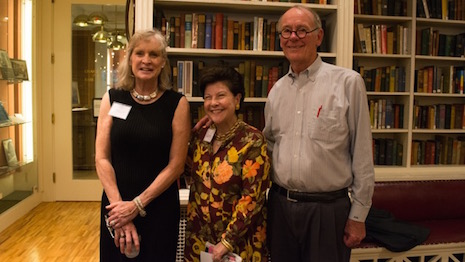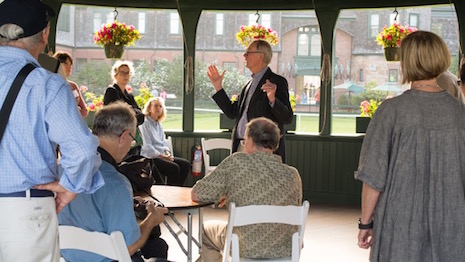Initiatives in Art and Culture will host the 20th anniversary Conference on the Arts and Crafts Movement with a focus on New York and its environs.
To be held in New York, the city where the prestigious event was founded in 1999, the Sept. 20-23 conference will cover a multitude of topics related to the Arts and Crafts movement, with luminaries from the field expounding on themes that resonate currently as much as they did more than a century ago. Site visits to historic homes and museums will embellish the agenda.
“The Arts and Crafts movement is dynamic, continually evolving while staying true to its conceptual underpinnings,” said Lisa Koenigsberg, founder/president of Initiatives in Art and Culture, New York.
“Speakers will also address the vitality and duality – the past being alive in the present – that exemplifies this movement, which is ongoing, living and dynamic,” she said.
In this detailed interview, Ms. Koenigsberg digs deep into the longevity of the conference, the bones and relevance of the Arts and Crafts movement, how New York inspired architects and designers, the speaker lineup and the various site visits that bring the theme to life. Please read on:
The 20th Annual Arts and Crafts Conference focuses on New York and its vicinity. Why?
Each year IAC's conference goes to a different city and we examine the culture of the period from a fresh perspective.
The Arts and Crafts conference was born in New York City in 1999 and many felt strongly that we return for this milestone anniversary.
One of the heretofore unexamined approaches is to see New York as a major international hub in the forefront of the movement because of education (Pratt), exhibition (both museum and retail), creation and fabrication and patronage.
A special emphasis on glass is particularly appropriate since New York has been referred to as the birthplace for American stained glass.
How enduring and influencing has the Arts and Crafts movement become? Who were its biggest practitioners, proponents and patrons?
The influence is enduring and powerful, and given the stature of the makers, that would be a difficult assertion to challenge.
At the same time, in considering the Arts and Crafts movement it must be remembered that the movement drew upon a spectrum of styles.
Importantly, it should be remembered that it is not the particularity of a style that defines the Arts and Crafts movement but rather its ethos, principles and ideals.
What made New York a fertile environment for this movement?
New York was, and is, a major international metropolis with a lively intellectual milieu and a market for art and finely made beautiful things.
Additionally, the city welcomed so many people from other parts of the United Sates while serving as a refuge for individuals – prominent and otherwise – who came to New York from abroad.
Such a diverse gathering – home to individuals of varied backgrounds, means, philosophies, and beliefs – was an ideal incubator for a movement that was aesthetic and at the same time sociological / philosophical.
What is it that the conference is trying to achieve?
The conference looks at the Arts and Crafts movement in New York City and environs.
This year's consideration is broken down into four themes and places a particular emphasis on glass, one that reflects the role the city played with regard to the birth and efflorescence of stained glass in America.
- Regarding education, we consider the role of Pratt Institute (founded in 1887) at which Arthur Wesley Dow, a seminal figure in the movement, taught from 1896 to 1903. During those years, he also authored Composition, a series of exercises in art and structure for the use of students and teachers (1899).
- Regarding patronage, we consider Helen Gould, daughter of railroad tycoon Jay Gould. She made possible Stanford White and Louis Comfort Tiffany’s collaboration on the Gould Memorial Library, as well as Louis Comfort Tiffany’s creation of the Tiffany Reading Room in Irvington, NY. During her family's tenure at Lyndhurst in Tarrytown, NY, Gould also added to the Tiffany windows installed by her father. Closely related to patronage is the subject of acquisition, and we look at the market for and the collecting of American Pictorial Photography.
- Regarding exhibition, we look at museums and at their collecting practices, notably those of the Metropolitan Museum of Art and its collecting of art pottery. We also consider display in retail, examining Gustaf Stickely’s craftsman building and Joseph Urban’s U.S. outpost of the Wiener Werkstatte.
- With regard to creation, we explore Pictorialist photography and stained glass, both important expressions of the movement that had roots in New York.
Twenty years for a conference series is long. What is the secret to the Art and Crafts Conference's appeal?
A set of living ideals and precepts defines the Arts and Crafts movement, a community. These resonate with those who are drawn to the work and teachings of the movement.
The Arts and Crafts movement is defined by an ethos, principles and ideals, among them creativity, complexity, craft, community and contradiction.
In coming together, attendees affirm their membership in what might be termed an ongoing living community that continues to explore and champion values which link each of us to others.
 Session in progress at last year's Arts and Crafts Conference
Session in progress at last year's Arts and Crafts Conference
How did you craft the sessions?
As always, IAC sought important voices deeply involved in and contributing to the field, ranging from scholars and curators, to architects, to stained glass conservators.
We then crafted a series of site and collections visits that were synergistic with and exemplified the themes articulated above.
Whenever we are offered a unique opportunity such as a visit to the Mayer-Loeb House or the Gould Memorial Library, we will go to great lengths to include it in the program, as we will to ensure that an authentic voice representing a distinct point of view participates in the conversation.
What about the speakers – what will they say that attendees will not be able to hear elsewhere, at least in one place?
Hearing such a distinguished group of speakers elaborate on the vital nexus New York and environs were and are for the creation of the movement is an utterly unique opportunity, as is the chance to explore sites and collections that provide the basis for the conclusions drawn.
The Arts and Crafts movement is dynamic, continually evolving while staying true to its conceptual underpinnings.
Speakers will also address the vitality and duality – the past being alive in the present – that exemplifies this movement, which is ongoing, living and dynamic.
The pit stops on the conference agenda are illustrious examples of the Arts and Crafts movement. Why the choice of those institutions and buildings?
In major cities that are the hub of any movement there is a plethora of sites that can be visited. Curating those possibilities is always challenging.
Repositories of great collections such as the Metropolitan Museum of Art, with leading curatorial individuals, are a must.
Additionally, sites such as the National Arts Club both embody, in architecture and decoration, and play a major role in the Arts and Crafts movement with important early exhibitions having being held there, with artists such as Marie Zimmermann having had studios at the club and movement leaders such as Arthur Wesley Dow having served as officers of the organization.
Other sites can be seen as linked to one another, and those connections warrant the exploration.
The Tiffany Reading Room, Lyndhurst and Gould Memorial all share a patron and evidence of that patron's taste is manifest in each place.
The work of Stanford White, a prominent New York City architect often commissioned, is evident in at least two sites that we visit, with each having been commissioned by a culturally significant figure in White's milieu and New York's cultural life.
Additionally, given our emphasis in glass, Union Church in Pocantico Hills is simply a showstopper we would move heaven and earth to make it possible.
 Founder Lisa Koenigsberg flanked by speakers at last year's Arts and Crafts Conference
Founder Lisa Koenigsberg flanked by speakers at last year's Arts and Crafts Conference
Is the Arts and Crafts movement still relevant?
Absolutely. In fact, arguably, it is more relevant than it has been in some time.
For example, a major cultural conversation must be had about societal and cultural support for extraordinary talents working at the highest levels of artistry.
The challenge such visionaries face in competing against anonymous and powerful brands that can gain greater market share and attention resonated with the efforts made by small entities and individuals to purvey their work on what might be termed "an equal playing field."
Are we able to create the equivalent of another Arts and Crafts movement this century?
Yes, we are able to do so.
At the same time, one might put forth that there has been an ongoing and living spirit of the Arts and Crafts movement that is evident in the work of great makers such as Sam Maloof or George Nakashima, or Harlan Butt.
[Similarly], individual makers or collectives that produce work in keeping with the Arts and Crafts precepts face certain pressures when their work is juxtaposed with more anonymously produced and arguably characterless goods.
Please click here to register for the 20th anniversary Conference on the Arts and Crafts Movement in New York Sept. 20-23
Please click here for the conference brochure
{"ct":"xgDWf9\/cJfJ8Y+xX24Bv8tbsl\/b4kMfQWxcwprZzW5oJNKw1s5gs06vLUC27DbTlK2Z5REdSFMPCf+dZVjaqufsaoAG\/6w967xw2uOR\/8aYrr6GUc+4yTK3LicamGiXXAuwH\/URflt2hVUbWJKaDA5O5x\/EmVUNci6E+56Oui+OT6azDeryZjW4+poicX4Mwxo9QkRlHjGcDK7bRIR54pCKiYNw3+jTDgIlxKOB8jEtVxe\/88DeMDA\/V8WTWM2Jxhc2PBDP8dgzHCitWIDpQWS78CVOEjBY3IrEo0JGTeK+Y01NzT7At5ezTxekLGlRsvMlUDi3P8B7QqNQWr5OWuozhYoaRSwdBJzPMkvmsi+QRqhERGiv1UXpGQft1RGU7JAYHGqwUXGIkjCl2QjwM5loSE+TDPRavKiWWcNaTRjFrKpDAUr2K39xEY0UThHF\/juuwjdXAvgjpWYMIM1UaA5FsfdU\/nu2+hQDnQzCN2MuR+Q8kVglQsnqtocW+4OZfjTBTzgPxYdU4KlDuOSVoOKaBsRe+051CfrS0jikTSemqnKuZBF9PApKaVeGWOcFbNrJUfMO3b0BJ5CK3kN2ZVsMDLKOby5\/L1MthyYXf+jaQUyBM8hB2B1ZxDqiiXsKcJWCWHL80Q5i6Gnmhut48D4Me7YBMCAJnE3NdZmd6SELKSApP4Su24GgtKDI78irHDSfFxtlqkOUDPpNesQzxX0aG5+8YKd+0\/vFaOUt3rtK6DmDLfQ\/sk1xaK3dVYIKcMV\/Ygr4JS5xC7t\/\/FWGhWohHqHzedJgnuCMBb\/NUUK8tn3AryHC5HERKuzIYdCh5F6UjaD75Ek6SQPp7MbNEmnLNjydODYBayTpDEJZwF0CV19RO4auD+VIu30MXCJcUhgeps1GRv0yd88lUkZKRBwrYrn7IUyp82bXE67Dm1r0WOoNWnyChXX\/Ao1RQq\/Ps+xrexpR+6aiAtWI6MhSzs\/lfNO1U3UbBC9DrTXCHL6F4W9olEbo7frJXWyC2XjnpPhMdW4k4Shi5fD84n+97x6vo+OmAn3MFvzixtgyaktBoOhRNVo7Mlmdmj\/7GwLjLappiEypvlKa2D8xUFeC67e+JSuPCQnUTR\/i8WaPfF42MPSSjhoEcpOv3IHg8I2xw17IrsfBPvW9qi0ivmiJvBK0UsPM5i7KkxGLRH8ny+d7YU\/DWi2jDRHNsum\/cEBMNYqLRxAa5EdWCsxhA19lfLp8dmj+m2EH68fDTsfEu1KlBfQFxrjT9qitgIM+kkJyoTQ9Qs2YdDlDqU+7iWzyYBoUroaN0wf+NhmSmthc6OzEM7JRGURaY7crozjRW7EDy0ZTOABJlJamsbQgaJ72\/0DVVNve9ExZtcgK38p1+tl4twHZBBwmGcY51aX45dGC1RcAQBEfYsLwoxStfaKuKcDdwAOlYrIighQzBL4ixBhFthPhoueGap7PrelrIMhKk4ns8TCuJwtTadOenSkjGoqk\/IdTJU9tCKkFFtESWy8sxuU14UgkYF437F364sFo\/Gz17IKdM8g6xEy\/J+O7Vb6Jk3w3Mf1GhE\/DPiIulstSh\/1EzWZX6fILVbSn4RTWS7yAJER8GRae\/oKCA2k6R+c50ymp+30F6+RIarIz4Vmuox4bj+oyqo\/b2iU6E1ch5a\/tzOOUQXyrcczmc2r6jf5zo5QaLD7VpOal\/rIgUQVbTwZn\/ccnliKwahQpcS7v2X8L+ucQK6Jmty35TI9eGEbJ6pUWn8SpZ8cptc0QrgR6F5FhtosEFh4DVDuXcV8Dh20kJVjgnocUIw0RItYLg2rz4cnGQuBudi+xrJ1ZP+\/KyfmJuGmoFjEt2AK7MpfVHvjub4GA1t0BYqbHMoUDY\/Bdm9KGr0j\/2u4AozT+rWmv+Vve8haRFlBgIn3m+AaLoHeha4wJmoSsXXJdJmf6mlo6jdBqhCiwolqWnTUAqUdC7uKr+HKX67Q0tIn3c4mfz76hc3WkLcZ+2osveBLaCu5f2lOPn5Fkhl3T7CSMY2VfJ1QN+96sdI28kM2Lxty4nqm\/SdMdmWXdwKG0fYY5U22\/TAtPfOOteY7K9Pubq3lcUF2HsCsqbubClyyJ4wKZT2Tj9IMDOuQYFvrlF7CN8lUAXgUIl0k+pWRtkmwAjKlBq4UrPRx4mpjrcGzgzXgYKjlfvA+D\/D8HfBl7oj65Qy9rNofZjx00Al4JSNbqD+c9kRrgt5Sk\/oRmNVVjfACzRG8r2YoWJ4hDiDfNi203mXt553mIxbEMw7bcHaydD+77R405eODZA8rNZDmnJehobWkUJY5Vfw5A5GxrUrLuIhhAjaZqm3\/9DT+1JnDfXS07Dopi0P2ghM+mZXPEpwcWxx\/0aZ0o5121fgT2IUB8iD7i7hsFaRoWbhR6i3nCiAzgTImiNEtzIXA956YxYkmUB4UZw6pEMa1zU5CSuJqMiWLhXhUPB5rTfsJ6Uqr0PrBdw1FgtaZittSMGu5bE0Q5aZ9RXKnaFbXYWDTdZZ3uU4LLZwC35dbV0dSwGX6p6nipiZL\/O7Zs2dTlIuLBCB7waNPrkyoEPnjeKzP0J2eiOoYzUAkOHLFTLjlAyTswqkQfeCJBWhKV\/Jq\/gx1qeVzPJUB7ajURjOlaUA26a0QtkHdZzovVvmAlWcXVhRuwxINTHFZsosOqWk+9Ioplk9cFg542rlrbiUfz\/oOUg4cyhAHmzF6pPW\/H66QoHcx2Nwg0+wOfHYrLjBYWd0jNWHYFCs8UPtcrUIh5rumBAV3hMu3ZmYiSIo0JbgeZmG6t0kpbYLo2gFNKrJJlDqRg+vESP9KmahXTnIn+edwwAskwJfaJ+rDo67gTr+yNvK5Y2bKJ32vTpK21DALneK8\/HoGpP98Iy9zV8nxbrDP6gTrCcHbN9DEp0jN40phHvswRK\/U3PcIdaXyXZR6eORh5Ddy6drcWbmRR7FG0RdWOmLL7nc9MpVN9jDsr8789MU9cwMWlPK4T7ISgd+FT9c2QQhTppwqE6vNf4gv26LUUrjk+dYrBg71HvZm8HqGu1wT78S+fm3E\/H+Qs5s2jMYsc0QJyLm\/3imvCl2TalKtHvocmqU2KdcFIuNpRJd78qvgmXprp8y8lEgHXmLSLuzsXetqMBL1Qx8ZXWY6SMbOuoK9E6zfzLaZPsbVH8a4ACbHcFj81+bs1IyUbC3cLDCbgbigbVrcNDDbnQgSmamKQTm33zvsAYD7V2PEatP9vxWCWNSU1AohhOVhgNHA++wPFK+ku9cMl+K47bcXfjVsTiRHFhyHrky\/kZF0BeoMPLG5rn0wqniD\/9CpfSzwkq3fnq8brDaaP+6fxfZf4\/3zyY5k7hF13E33\/ZX\/vVwzWTtZ\/VkE3TPaVMzb30lS\/hb1f1IbFM6jei8BhnkKed4Lkv0hvH6Tgur4OrQ9BrRJn\/C6GL1fe7T6pH4VRkoQHUbPdqvMli03hxL11Xl+IknTseKpOIm+e\/jyfJr6L6lX8TkbsMj4GYZktK1cPN\/t0XKUESxM6ja65G4UZ6UHSzxOyqfnee3xZVVf\/6YBW0zHKGQtdAWzX4i7QdLHbvWhB4Ru66l9cxpfKweFbEtg2qTA\/2KScGUeFwi5hiKqOxRwLRib1yEHs3C9ZR0o5d+Vk6hNSPFOcz6ER0863c\/lytjebPfbmIYAF9E20xLiPd+Nc9Z97wd0e0AsB6zDkr9ePsfXr5UmvzsKZszh\/2RRYVwebPJdrQTNUS7ARurclSP1N5Dcm9H2FUCLm5sMLp3LYIljK9kzwNWmBAS7TqQiwNnnyQIrvLNdKyyZ92hAdUwEghrAd3Rcb+7i9Ego7CJLpM3TKoECS+9ifEim4GZB2nDh+PE\/I0dLx0FjeCM2pHBzjLsEGhyYwB6XtwznWes\/NH868Na7rpXgTwKemZd\/mtswNoMj1rW+TJBLYlolE7BgT5kS2aT16a\/mQAcUTYimjx8cu0tQD6PEm\/FoRkM6r2ahJIxcL0g2J4NO4wXzarGWvGdnPS9buRCHFSEBGRZEXbtv9g3Y8EXRnfbBH3h9CjF9TYVI6nXqAtxfcTXgnj9lphIoJ9FhZZmji+R\/lKuzlXSXNcy43Jqic1sFnb313sq2B4CGtXSW+ty8g8ZiVScapSv5bdlcNU3vllao1ia7xON5CeVqB15sQGpy+ECteQfc+9\/4ShTuNedzhy2pFUqLEcn39cBkNLzg\/VblS3JlB6tqQ92mT8EN\/F9SfxTqGjOL7ZU0InCFVekeAYyJaelFQ6IxD9g25lqSxaZsHphvkAtMsn4lC3oMgpRXKXM4GtDpD9JxocK7ahI+pGRhcYn8tfxFXnGXKPPJSOc2BEFo2+vIGbd3lkK7jBiQZY7shfRjtRNXSdWsCAqg2+nCn23DjsRfXmPOj2Y\/OM2XhPLmlDzqtlZzV3GA4xpgJVFOM+I+JKiRTHYh8XMbArD7xUoZZbKPT+Pvb73dSPmz2S\/SkwNWXGtONcneM5Zc8bM16sapaaYOdmPaeKTj+Nycy7QZSBaWOtEPkdw65NM6rn1Uf\/puYZsc0FKmPcTYXns0xwxYJXchbg6\/Jpn2q25ZprB2dTEiJmyl0SDEwinJZ\/C2GwFJEQEyIn9NdiTOG6idDLcCzCr3PCTMLc7DgVym9zVL8NzhQd++W+cJ8Zh7tgZFPfM0kJkP9UO0VSuD+cU3ORsdmTdP4lPYrQ557D4JzY4smCvkaMjHrvDnNgkG1RMv5pBaQjkK4AKh2M3lh8dql\/3qhIGEmo50y+WgzVZoX06la1MTKVFrjLunhyB+\/6HPepcsljdG9OFY3tkCsWnpMwqyN4\/wzzpUmq3OS4OmowqBDk4jWZKDdRX\/nOSuzptd6q5UJE6rrDXbhcaVZJ5S0652JP0\/4gYZFoQrhvSmPFDTtj6UwEsCGoAGv8BMxTt\/mY8d4NLfraR+SrXqJ0b9GuktXgLlDoO7cZQYxXiYfHL2nHn+osvFkBWju1tMxCGdOpYWQRJ37O6PZqZkNj9a1uFHZgB4DrWfC5lQ7EXLPDK8rG0qMypw2OFmhQSfXl7BsriQzvxgsxhOhkIc\/Nef+led8jUhsPPOVYmwpJSe\/6x76QWFYDYR2qyo8lXYwSMWrPFoIeoU2H01l6SxqJVTi8\/qhTHRGxkYB16wCxg2aYK2diZ5630LyGBWi6eMl2AEvZtbR+Q+ytN2RyQ55Jif3qtniCYRN6ZmpCpIDWo8hJaXwZv7sGegehnlAguTZ+Xw+MwKx09ySDJxa01ayqBI+v4nUQuwDRx4IE+7oz+qCd+P01EGqr1xc6LN8asyQi\/9pI4y6oMtyrksKXMln+UsuIs7URTXPPTFTj5uXSduIGaLQX7\/qFa6yhV+UOBZH71tgxlVjqvSALoRW37LHt\/eaqUPP0Za0wsQ+hV8UJ8NDia6WB5+E97gG\/n8XMkEmN1F5O2FzQLyGB1VA0Rfj29xaTRz48uZkIt9r95cvSvElOj1G+EYzlQd\/XbBQHrH6LltoDtMBfToXTcGDAFMlHt1y7kwp0G0Kxuhttd4yhHjAnXl5GwA5tK1bUddF514e7TSlpZbEvCc+zcogT4eTt6ss0IL7sTbBrwDoTN8qqajiz7blkAPddslCyqy1awrjnnkqZ2PBd4Mfls5itgqCGxulnQlwjlAf6Ua0DVahDy2xQtRj5I7ZgggF3bsG5iaEY7Eh0GD2q3THfmbYDHfvC4K\/lycENLIs9mawlTPU4Z2jls1mbwpBPp+3pLoYtULHJIJvB\/sicG1IkPWGzuELyCdtWKRVvrNRGkf+Sj3KKdx3oIutdth3NbdJvcLDFinaxoeftf1a9\/+pCTToH4d+PltQqb63eQcvYXNc1MeOGErnDzI90tRHsli1rS2Ysn3YIZtzDarXIyj3gefh4s7KexFYy\/3jEm4Hmcdb2iV\/5\/18HpnoXHCiQI3lIO8I7bmLANFFGFbBiQVkZfomwSWLI3yg\/7P4yCAVBZt92WSDgEMKNBBiuh2sTu7\/Nuwn4BnKRHD0ocsqRhqOwWVKSsTFHFkODFYlq1hnPv\/z26swkucslS4qrctEM6Tkcun8Iq\/GvhwXPrmh\/RZL3zhUdKQ2XH9Js27lYYYRAfdwRodDJ48wtWldi+aV0sxkwieKUHBAjWMvALnwZe1jEj3wCwc5AJj6MHgSi8Wdhw0PblvsCMeD+q38HZE7iVnZ1Luj9oTyhUsOFe5ltjohrncVVfjBKhKGAe8GMuy1vx0+zJhfxPcaNoTr6glP8iiOlRizWlj4qjmzP8LtYQedrwySUQe3vKtplX69\/iiz6mdF79hKFOKTyWwIJsRasahT2HFu50\/CELiqMyqBzOxI9Y4w131rqfQwSJCvUfIzSrN+ot\/kltaQuq2++kh0EnrpgmEEm6oTm7f0l59Q85xxbTw9MoNS2ZoLO3\/jVbPR750Hcj3G8LVtVo\/EDhrQb6\/RRlfhoPKBAuYNBkVozTbZb7J4kjBeWTz4oZQDjerBJ5Y0AuI5Oa4+6dA3hAhyoklOMKaBbgeVmY4V5qGNN4RomyhQTctUs+FxH6AylA9zE8pr6UkCKhiqKb\/GXUAX7yOmYymDKmJJOGHEfjuk5UL0Tvs3BfbhE+zJQzlqpaREeZlxhfUBDus+nSegdE4Y8m626usFvXQ3KhFrJJmqvkc1lj3ho6Gj5zvKjObLTGwSDUu2JwXV7\/S8HBIzssnxK+AaRGnXo0nDrXr+x5DnBmH7DjT5++T6rHeNBoM5ohssHnKy2Dtu6IQNF0zWq54HNel3hiS02POXVownI+GEWapp3Lx\/HdxOMFxjs8x3z3S0nIfA\/aVGuBMnR\/hwE64OGbaXwnW7QJoT6sXUnRNeYcUNzpV8aHVZ6rItw7YDZxX0dZPQtgJoU8i7aAfue2f6Ifxwegx9Ev5R6UpEmRnN0YW9nb7HRJBQx3qVRN5MTCWZnyTHNhXo7o4SbEnXVcHrihS7V1a3DeLulfqogsFeUg7hBhna3gvwKKnX+a\/rFxuesYmRMUZK6i5LE8kV2Hrwr5xeAd71zTiPLL3dEy04IOQfOr8qOYBNvOodnwsj4KyiyJL6o4DoHeG0vwhvaKBVKGbhI6sujZf1+fqoB5gHz5tiTc1tekUA6o5Trz2f6zqJ5x6R0PSrQ7LnyQybEe1HFJsAPAKWukzH+Ygod8xyd7kMpBkgg0FjYAcwAg5nZiVmrXIYA0x+hIXCuVeGpK1GM9fK96KmKLmB6U1skA2NKTmjh+lXUWqmIh3LmFuHsUI1EY\/vfxyreZo3fypZXev7EZy+ceAjr+tTJaf6oXWf0KBsGGsoYKCWE1oW0pr7yt0weWU\/EIRZ8s\/Si30OdQc3CdX8HIUs6Pi9S5ifI1RBmWoXF+bKdNgzOxy5+nq99V3nQ3DRuc2m58XQArVyEhL+mcw3dXS0yvNxnWaGIurlE+lfFcXGrQnB+AYYmjc2Vqj3ex6lmQ3nTRZLP2fDv1weSGfOtThMUMhv2pTYvCW5Ra8Ge\/mXTGbcwgSjFQKmWbHOEbTjFzxGkDWhlptmJGSV3qyax9PxcnmZU6ujuydLUKC8gJlWzAtcLIkq3MM\/9pLZ3gojUMRNvIOGi0UNcMTDksKkIYzYJ+pAFZjrp4jU01+LRUxeUq1OEh+g3xARHR2vQ5OgE+bPCExSKc1qRIwwGIXAa8HPc06dxTYW9ryWfnrr03G+RXN4wyKMHOMGQyWFjHEG+kyVKkjXRoWl7eWFeehJuzjfWbZtyk+X4eMSDsz6LRlwpFpjWL5WyWimjasRsCQMX9UjIDXCEyQHV3P9XpZ9ImbqnEDw1oXwyuF2W2uZVMJUGgpWZyzGndXWZK4M7Jitpyokbbe2sg5ZJHH5RI62rL+LQ4s7QdxEOMe6RPXml2Q\/XQclMywilcv5gZiIvRlniCs7c4ONKK1EKnCXzyiBpzzksUo\/xk\/3QWAQThkr13shecPEuKvM0pTg4pd+oDQE9AjEMCNkbgutgNfs33aY7EuUn4CamUw\/2KDBsMFrybKOHrsNzJ7VJBC6jNUkZweS67zE1OzuRx7kMF0ZCyIf5d8f+BsvuDsbRFncWHnHZvCAL9W98FUtWK8ol56d6t5T2HvhLvlme70OiKx4UxPqgycG85TXq6tmYHFVXaZX2aQEJMr8SFuw6JiOyTQPMHF6TkIgGkUDAS\/mRD94ojh5negnCK5Qu\/vH8kO45j54JjejSW1x59YqYIWZl7QyfCwvTFMaebefvuXf9QOlrSLpzFk+SsBqdN9NrE\/7nfLNFfDap+s0DZYKrDTs678LIzaWxeBRBrgMyvmAOdbTs1k0M5e1fUh5EvOugQZyNlDgkEAPPIDA2eZYXnvtqecBTV9R5ld3DU+7io5cIyNzdx4EPPe7AayDajLl4H2yhEo\/SeEHwECzWe3aqdANFiU92LTgI9W1DdZSf4j74hTlWO+FILvHtS87UQBUzbIgdOlueVCiT0GlQsTy3d8VZMET7fBODQv7L39rUiaNSldFHCPUB65FOLAbbpE5iWIV4YdekCcHqwT3JEiWBZzeJgsi74Zb5i9S+NTuGk4Ff5sCww1W4cJpg6dIxnVBgZQfwYr6vD3TDNe7skE5gG54xrKPlTnUxc4uaOoRQlhL3QtPS3qFhoGlk4BggT76Y822ZlOtlqp28AKLVL\/m\/jBIgxijLIa\/ZqB3BnysiZZFBNTdnJvMeHpNqRhVFKG4qNoBQ2pcy8jzpzk80awaFuJ9tFYWnm0Dg9D4peHPtWAoJ\/psnIJyuIvBe4HVEwYERjEUYwU4xiBuK+0PeRJZzquUYrWtGvXhD6kCQogvnaG6\/RXQ4ByxpMWw0xDrVDD9HTE\/sEUSXOJMcKbB1jkZ+im0tKUZNNHUiPEJo4LlekdWEg8xuw7ppb\/R8t+vIM3O+s\/QtpyEdqsbwQRy0o7JZw4xwDuKIrno6hcxmoYHS1yC6UYduuwu3+5wtWv7T80gG4QVaX9WCVxIskfNllr3qLJdhG77Y6vP9sqyq+xJnFIko7Bhy2D\/daC9dVo5UWeY8Ez273MZuUOI9zxjQgEirppfgvapCZ0W1X\/0ocZ2LGCKYX1Q59gSxRK5Qg1xYUs48fbeQ0OsruRJ5KQPr182WvyghFdNqbSZ9wTeyruBhNTIQ7ZoWY97zM3FbbcYjLq+uIEyBWT2spRUIY5pd\/gKCLIVptSxYFrrNU\/s\/rBvruFahPmHFO\/u50yq8fthw7MzleO2rYHsfvPzw4x4dneiRwyxdhjm18OzrOE0\/ZOYIYNoqaAgY\/K5OU8wON1+9zF9FWAT9hKNfui+NkugfeBONtTbs9ZTNNgga+WT9THOFv+FTJVe\/roZXldlufmIuW++JqI7SEhXXUxdBcoCsjTjQGlNvgcJMo8gh54fsNeeenHP7aLqT7rdR3slZKEOwqsqppQ0ivHXQbOKwExJ2IXTiOpNjuPxlNUAM\/OUHF6t1784TBZy9\/yotfvfGWlj4dd9\/Z0xhRSKSKeePwSdb887dcnqaOn6PvRTWSTZuZMAIw11h4DeQtm3TmAqU2SZPxOK8+EeMqsiMZgr7xeba2xs38wHnYfN0A0+Oa9Rz24wLdvOXQqU0lBXWhOCR6A45quu5iBtVYVWa7rGNo4HSzBU2v27HydDz3J\/E7uAeKJsNOilKOzzKqWScWoXQh1ywtF7B+dc8s02ZFZAsWvRRZG9O6QRV6eoC63muPK+YexfqQcGg6JKn1JmXOzvunm2WS42m8oDrnh\/Uc8irLFJsUanXa9Src5W6R\/ghzaaYm\/NF9sHQ9Qk0kwk9yY1dRt6KBAB\/A6Z76SfvflOr9Uqyn\/aS6pyKFs7n1BrrjxOFSAG4V5WDN8AtmyhgcVCL7FGgqwzuMen0djrDEbHyuN9qsyjijO57YZCPuZvmdxCcDYvYHeDBxMMSJXDU95OvOWbWwEKAL6SJ8dezktH3yIT9CLuSZsRLW1fgvp1gj2tYv0CoB4X96qntduc0j+2GWYe5AQNddp4+VVbQSVZHbXyXII9pYob5Lm6KQY7+4OnSjhgj42HZQ8V4L4D1vXw5YeURPBP3NsmtrLsCKL+1IpUT6st+5wVndLIOP5TEpTnu59xuMh+G32MELZbT4ljezcL+pD6WNnJQ2z4vfWFXNokQy23KWFfHhPVrjafJq7a4IK8WaLJ3NGZrFSj3h8yccXSJO4Ov2Mjnz8Qt8t\/wjRryQGLdNPyoU3kYwboj2ZC4tEWJeOr0uzs44soSJRTG6\/QeP2w+Q+pM0YYgCPGAlxJIPHhAgYiTYjahN1jMv7OkofcRs6QbiRIr9tLVCLvQyRAPJmCgjLL0JGiGbB+jgh0UgJ8ZKlD1ocvIsbGsXjpW\/aAiS1+OuzlD6n6\/K+3LIimKkWNcyGSSQS94K8qfa67rjnijujgnW+62L9EdGucUsSzrZ2gxMbRYq34XhGt1nrbL52qNZJPzCSdHLIkzVsT5GS4YfgEDHfy8oArd5jrFzbP4Li8pNt6MOdVPa7Q\/YPYCs77Nu9YezohivCfvPxibPcaS0HCyTPtVw8NFneKo3cazPO5eDR0bEjLAsAP75GrfRYrv5EUNzJXNnYDRVLartDUbmC3aN74WstVLjrCBki3GcuFKVnCQDfAVVcQrVhJ4\/YQ9nMYpO1eTECog4uufRVsMfgLDIpkqwuv1iBRCmdSIHf7\/bsIzm5j2KtbRGxhUyYVd58TQaWRiSIjmaDlvievLwq+dx2ed+AqrARcJsem2jYN\/7QspN\/uUxLYGU5WSvQAOUbYwgulAeR\/p7JB15MxFYKiM8Yu6813xWgq\/PgmjMyypGFceGzGsfH5sN6Wp68IschL4BFkLcF0yW8wooVZg1VFjcMOFZQsWHR1TRBSffPbF0fRbsyFHJ2MmH0vRjdhnZ2UF95CyWPAaGzdt6TPYPODyHd2xOoxNHH5Z3aBpB6J5iBMVXRgqTxkvl4tEGRHauokQjCQeEoGCn0I6wg6Ddep9e9efM3fgTu6XZ\/zZrnlOuqcKI23+SLxaXyuSIXxEFY6FGz6kRF1Wt6w2+j0KCmd5eom26NQhofaIRZYooUYM18PzDqBeVTwE2OHiDKcjGpz9Wk082xYak\/QX03h5NEitVLbr7AwS+TxEAn13MvfwUTQSacsOeUMWWFKfAQb89nHNy44gPnFZCvGx3HEi6NHa+BQwYBkRxdKY3F2E\/FTFp5hKtVNSN44J4y1Lgex33ioAiANl9v2UFZ4XS5kR07AaibFLiFHJL2tarPw\/jPqztshHKwHYrGYaIbUtGgAy8SwvH3g76vnU4iZgDmQuJ9+AagPm5z6YEhO3CkjEiMOwC7bd\/j4K+guBMpO9NkjkAG2iXvgWUmfSv5Y+dMA6YjTBW+Zo9JRQAj39jqOhqcDQ\/Bgo021v+JlLDPwb+M2yXJXRVLx\/BWDRph\/+4gN6dSBfSfDegFNxLO6zpTtipIEdlic6YwDi2oKXceqkRycKUyz62xBmuHf7lxKc0cLOwhxTQGSir33AGQaTxowWiCg0K2cVeCjP7KbCb+o1KRCq3Xiy6Zddi2xGnkSGf1EnNfVs7vRkAy8IGzNieEY+PvSQO\/FZf6XaeJ\/x2UmEyHGlNQQuQLxvZ4GhCBZcdUWFR5HjkSl7PdqVfyFR+P83orR28MACK6OEewyp0uLwpYx1wKPDlEwUayH5NeqfnyLvFiaK8EWIAwX0hoqTnwKftlVnjsUzLKOU0wD5XT7L2abkduD3U\/LGw7h9YzVolciqjFMmU6fxVRDnrlTVGREFSpOY3uKz4Ld4NvRl8TxObxmDml8+TUxcpalt22uALvS+r+ayE8Q5rvs1Y58p\/YtJmCQuzUyshu5Feci7hgfUHMPvt6etDW562ah2Bmd6zop33Z4fR\/0z+LxGpvRoQsJ5LMm9J0SeEZws4hR6DFd7YxP5Gy6YZ6ckn1vAYldyzI+7v4uFcLbc0kjFwRfwI9BFucAVd7qDrrld2gKYYCyKlnui\/8jQw+eZZGgLdmbDE75kBauU3sg1vBY0vy2Kg9RwKH+lM09eYvzXnvuxcNcNxhHA72VgsULLtb8gtzWJRAkuy2Lz7rQ9COB4bBQruhh5DnaUG\/UWVbCyRJOECmJDPvyHRmF87IHZCKgokEIhusNq7QuVFvmgTXg1NEIBZf8igt3gNjpFBlNFCRg08k4ssfr0PTh1xVl8\/cpUQ6R7Cvylc4Eg10U8Y2HvG5BmBz3ZqjijlMxwemT1acmERbkl+Ff9aH\/LKvlqtcs84duvKJJ+szcdT04Yl9H+S8Hi6i64+toRwj66ChoDUyhTmCNGAtI6dP4sbGrV3\/NDwlwECz+GzI2vS378QEWRclNB\/O8Naxbecjadom8RKi9iSs9cDjrwetkJ1nBUFIB9mpaPEmVVtRyevTPwy0yGOtKWp5iguiY9x5GUZ33aQCCxAnecS2uU3+Tz\/bYswXL3dfGpH7er2hyi9rTahCapv+pcbfVg2kLMK6y97QOVsvJQ6SuOOQducEzLVphYBmPEZvu1wGg7XrZWOiGmPIwFy+ienS\/A+T4T9Cd5RgQz\/lAp4B\/FfRWeZQg\/1+QpaoEq8gl7fRFvs9XZFM+ow9FXwadHzzm6b21auWWTSwyhBY0\/p2zdJEU0LtUC6on9EvX+wCEZmSgJFapf0cC5wHGGk+P3Qt0cM\/HXogovAbFelBpSbiZl5UCaUX6LGSzW7Wue+xgi2Zo2TForiK+qY1t0HAJekKHCuAz3rxjQJyJTnluzW\/pxjnz78\/lm8FDPKOQWR9i6kt9INUnpL6gxE00rJbv0SDvj2z0DwUGvw8LFwO3jOOQSE5vlAY4IMAkQZ0UkdcLsdRr+SwpaiMFpP+XXhHN1zDlKmMcxTRwhQIQafuZUTNamdDjuYUpScV8kAPGBE4dJlTCLMpdSGjfzY72MUdmEnzoMxIpSmoRKw831RXQndgShqoM6ug0UFUQWw7dX+4WWkJgeW0vXQlgYB5bON0\/4PxzNkVNqwd6\/3rIHcK4JF9PKNnPQ2q+c92kV3umUOSb2EmeIjO8IIS\/T12p0XnjcsSsXUzbmlU7r0uBNwZr2qiFYefHVKapFVHTIbPmLo8ahG+YycDFZWoQBGa7TUHf7M1Hffn8cHxt6AiLnCm1a3rn\/WOrns0vhl9qsKEdlnhF89B4MjaZ3NyD4C\/d+rJk2vm6WJm1b8FjM9rS06JGm6GbnasQgCYcz8Rv05lX+RpAXDfL8TAYFTFw8eYlkINlaVNtNnoImqMlM6HMt3ndSLICI4REshMix+T3wZW\/dWRmi+ghn9\/X+qfTE2fpbHpCH1qXKlzDibqI7ZOEVG4ejhVypTgWR1YOK7yBVoow9KLtB9Jgjo9CoiftR+7RMlet\/7qTbZWTdg4YaCCSBvarm5ZmTAetXemDJtJ8N+eQYVE128gIGXTvczR1I+Bx85QBGRjG\/kBiyEqGHQWih9hT8PRL9YxrUIS9XCAKl9eQ9p\/O8nczCmqYcoGdwMZ78MA6NifE+4Lxkh+qunuIX2oiraYS0rqn7MpGPcuFerX0E9tNOa\/i574\/98DDN2jfKIzrdziJnBAYTOuAs3DYZ\/5ztzXkwnEkqaHil+1FA0nHayULgOAVsWcROrkBgtl4WhVK1IUUu5HcPFpALmE2Yu1AxY0miQKnvJBRzLi5Dn6ZdGHwBCwRC1ptCMlzqAcNaRrTrm\/QUmvATO5P\/I47a9vekaReuoqBGrqzW56QSwdQJyswJNZJ\/W\/2fAk77YAdIdYMdFpbvWPJ3YqsC9X9RGugWl5X9jV3ZKX8IdnbM1lzlEYswRAOeZ0+S7OpjJSizuJC3y+Q\/\/4Ba9EZ0OJnq5OfLcIXAEBRGPGZ3kqhoeL5c09deqj52+SOf\/YYTHExwI1mcyZVKRtMue7v9P4R3AhPhWMdIzWt4jZimRYk8br0uEqtfuIl8SE3IiaRCafp1iQpU075KzZmR2QRx+dYtDOW65SxHxER++OWr1V1I+s8rzyaVKLqcx4TbUbumvVfI8Ea1K1HqotofV8wvnh25MTdOoMTLGUJJls2evNbNpkh+JMQcJht9MQwWftEDPtzuSZ3tW15eyEMBewQS316vLWO9j0cLToqqLbgL3Qt4N8rOES1\/eS5N0E82h6Bh7vCssz6Nz8\/yFxGdwzXqVz7c4JFMfFp0gRezaf9TFZNgt0itiOT6BN0gpkS0mIV3jSNxUhFBSqGk1ki7nxEfEO9k94FlfC5Jp9tZe7PgUdZy0YZumAjmJf6B0aTn0uxFIJEy7RlWgsxh0t9cpmQhuunDmty4kvYZwGLyMl7q3T+A8PZ9KYJ+QgbnINh7iBXzbgO0yB1af9mRnXrHY5jVtDpp0UCuntW1a\/K5VSz31OGO30zDjUiOt1xXLiyBX5a0LlZSs7TrEZIJ6WQ\/1xHEemF0WroPQcyitW7MFFiUeHrXzlhgLRlAOGQM31Nv1j5SLjeev7clqjWh2\/CsDewAWwQGIMlh7ig7ghNx3yVaPjr9buQ4jth4mNn6521IK\/3gn4m77VMhBlmRrUrAouwP2AMFIuxxdRqIXwDSBcVTP6qqMmliZ7unKR2THBFKg6NGn\/at9JvF4K4pfwm0SEeYITdJ0G3PfOllfk60WFOglyAFjtvpSXk4fYbbr4BIiXWey0bXHU89MhuXr7VuGsLy96Zns\/bTxW\/gL0xF1TUItObr+Lr3urJJ8csIOnJ277DimGFHJaPw6vIO02F33QQKvNNNEbNL+mG\/y6P6VAss17Sxr1LmGGYTjs2Nx3BiYnX9YbrSU6E8ltQ8uCBqj3H978w7RbAE7gZsgKwv2ytN14y2Hzm5klE20KkgdTdE4h3VUMRSE\/EdA57OzQTm9W0s9h5Ko\/dS8rDIJThOFnxJAf9ldxY6SF1Ik37njMEDMgk37pKRSG1YZlRgvn7P496r\/UaiyLIFZiHP2Aqcd5hu+6CKdkRA6tIJqv9fNe2XNyFdOXxGK43i7nY82z4oh5N0NFRxEOdCDYc\/SQmOK+BwTFEb+X9Zg7+cwUA2htq31DVs\/kAELGM0VyQDoGWm1B40nCBGXBAuishOWWR4UKzUKhv7y5ItEJOh+fm6cFvKXfGS6YikxdaGyKBJta7KPBOsIjzyVhnIgpnJLoAV4+qA2FTPuVq8SRzEDMm173GOFkJ7x\/6M+LfUcj\/0CuvDocSZIpE5vI4wNrLWza3g6Flc7PIYlpj2B7wOj419DWQWbrlVWn\/mpsMGdNPEJKjhg6H5cI+7toCRlXkXYs1Z5zTxbT8120RXd43mH\/SseZoEt5A+0UWXjsEd00HUB6nJn4txx5UXZu6zrizhcJ0pmYmWD\/+Qr5L4Xb23Yfn9VQ4QMNstqp9Tiw\/ovJ8Df6YIFA+6Aad8VVUiffolZdRDi\/kx15\/nUzLjO1OzsbIP4IAXqtWVpvYE3ePedPyeGgEZwQEhYJ0TJrZNzUVLBhHknFGfMTZylHz54V6z4i5kYHXsRFfoizMAU5MPNtlktSiP1cpJuw\/FUMiXQIUVoo80YH4oHCvMLvd9ltV7WL8+wmatCXWV8yK73maPjrXDmmCbxp\/gnE77EqFIp\/JBVVyrXVfm4mNxhR4n16SanArfwOir+GqenlDztiUzgr+h0\/8qOyLob1KU44QZ8Lce1PEYBOqyZLh4iyuavD42ebnM8JJ\/20kXd6xhIRFbgixxBD5vhK4aq7pH8dsidSJYlE9bGqLK6hZ4SyVLL5LabotmrMmL87roGevAOlDIKJQQr\/TW0DwXYl1R570pQjdCXIroYaTl27H5","iv":"8cc3d4cf6794471ab63fe82cc6612e59","s":"383de264aac9c170"}

 Site visit at last year's Arts and Crafts conference
Site visit at last year's Arts and Crafts conference
 Session in progress at last year's Arts and Crafts Conference
Session in progress at last year's Arts and Crafts Conference Founder Lisa Koenigsberg flanked by speakers at last year's Arts and Crafts Conference
Founder Lisa Koenigsberg flanked by speakers at last year's Arts and Crafts Conference